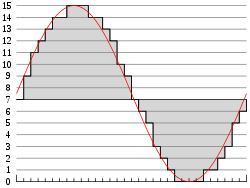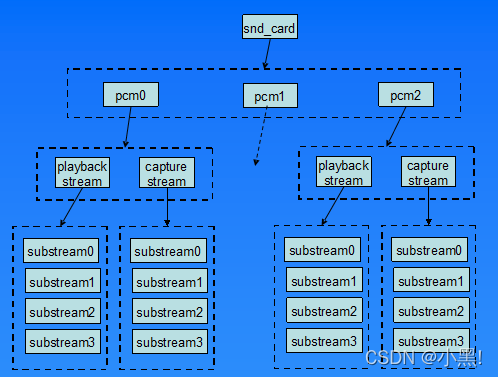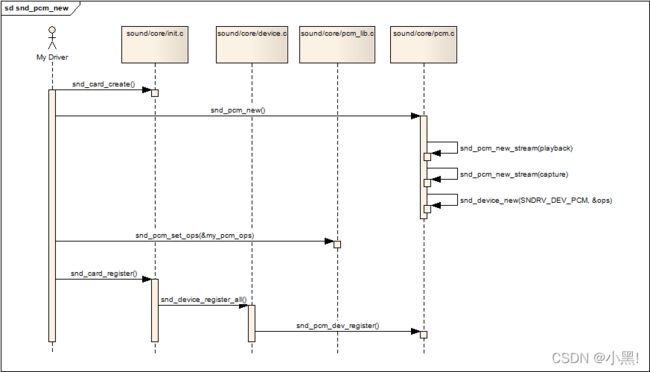ALSA学习(2)——pcm设备逻辑
文章目录
- 一、pcm简介
- 二、pcm结构详解
-
- 2.1 pcm框图
- 2.2 pcm代码框架
- 三、pcm声卡创建
- 四、设备文件节点建立
-
- 4.1 snd_minor 保存信息
参考学习地址:
https://www.cnblogs.com/jason-lu/archive/2013/06/07/3123750.html
一、pcm简介
PCM是英文Pulse-code modulation的缩写,中文译名是脉冲编码调制.我们知道在现实生活中,人耳听到的声音是模拟信号,PCM就是要把声音从模拟转换成数字信号的一种技术,他的原理简单地说就是利用一个固定的频率对模拟信号进行采样,采样后的信号在波形上看就像一串连续的幅值不一的脉冲,把这些脉冲的幅值按一定的精度进行量化,这些量化后的数值被连续地输出、传输、处理或记录到存储介质中,所有这些组成了数字音频的产生过程.

PCM信号的两个重要指标是采样频率和量化精度,目前,CD音频的采样频率通常为44100Hz,量化精度是16bit.
你的采样频率越高,你通过ad模块播放出的声音还原度就越高。
过程大概就是
capture —>AD模块—>playback
1、playback 如何把用户空间的应用程序发过来的PCM数据,转化为人耳可以辨别的模拟音频
2、capture 把mic拾取到得模拟信号,经过采样、量化,转换为PCM信号送回给用户空间的应用程序
二、pcm结构详解
2.1 pcm框图
要访问PCM的中间层代码,你首先要包含头文件

每个声卡最多可以包含4个pcm的实例,每个pcm实例对应一个pcm设备文件.pcm实例数量的这种限制源于linux设备号所占用的位大小,如果以后使用64位的设备号,我们将可以创建更多的pcm实例.不过大多数情况下,在嵌入式设备中,一个pcm实例已经足够了。
一个pcm实例由一个playback stream和一个capture stream组成,这两个stream又分别有一个或多个substreams(压缩层)组成。
2.2 pcm代码框架
在kernel/include/sound/pcm.h代码中有对应的源代码,这里贴一个框图帮助大家理解。
我们从中间位置开始分析
1、snd_pcm_substream是pcm中间层的核心,绝大部分任务都是在substream中处理,尤其是他的ops(snd_pcm_ops)字段,许多user空间的应用程序通过alsa-lib对驱动程序的请求都是由该结构中的函数处理。它的runtime字段则指向snd_pcm_runtime结构,snd_pcm_runtime记录这substream的一些重要的软件和硬件运行环境和参数。(后面有解析)
2、snd_pcm是挂在snd_card下面的一个snd_device
3、 snd_pcm_runtime结构,snd_pcm_runtime记录这substream的一些重要的软件和硬件运行环境和参数.
4、snd_pcm_str中的substream字段,指向snd_pcm_substream结构。
5、snd_pcm_substream是pcm中间层的核心,绝大部分任务都是在substream中处理,尤其是他的ops(snd_pcm_ops)字段,许多user空间的应用程序通过alsa-lib对驱动程序的请求都是由该结构中的函数处理.它的runtime字段则指向snd_pcm_runtime结构,snd_pcm_runtime记录这substream的一些重要的软件和硬件运行环境和参数。
下面是rk3288的pcm的对应的代码。其实就是通过这个结构体包含了很多各种接口。
struct snd_pcm_substream {
struct snd_pcm *pcm;
struct snd_pcm_str *pstr;
void *private_data; /* copied from pcm->private_data */
int number;
char name[32]; /* substream name */
int stream; /* stream (direction) */
struct pm_qos_request latency_pm_qos_req; /* pm_qos request */
size_t buffer_bytes_max; /* limit ring buffer size */
struct snd_dma_buffer dma_buffer;
size_t dma_max;
/* -- hardware operations -- */
const struct snd_pcm_ops *ops;
/* -- runtime information -- */
struct snd_pcm_runtime *runtime;
/* -- timer section -- */
struct snd_timer *timer; /* timer */
unsigned timer_running: 1; /* time is running */
long wait_time; /* time in ms for R/W to wait for avail */
/* -- next substream -- */
struct snd_pcm_substream *next;
/* -- linked substreams -- */
struct list_head link_list; /* linked list member */
struct snd_pcm_group self_group; /* fake group for non linked substream (with substream lock inside) */
struct snd_pcm_group *group; /* pointer to current group */
/* -- assigned files -- */
void *file;
int ref_count;
atomic_t mmap_count;
unsigned int f_flags;
void (*pcm_release)(struct snd_pcm_substream *);
struct pid *pid;
#if IS_ENABLED(CONFIG_SND_PCM_OSS)
/* -- OSS things -- */
struct snd_pcm_oss_substream oss;
#endif
#ifdef CONFIG_SND_VERBOSE_PROCFS
struct snd_info_entry *proc_root;
struct snd_info_entry *proc_info_entry;
struct snd_info_entry *proc_hw_params_entry;
struct snd_info_entry *proc_sw_params_entry;
struct snd_info_entry *proc_status_entry;
struct snd_info_entry *proc_prealloc_entry;
struct snd_info_entry *proc_prealloc_max_entry;
#ifdef CONFIG_SND_PCM_XRUN_DEBUG
struct snd_info_entry *proc_xrun_injection_entry;
#endif
#endif /* CONFIG_SND_VERBOSE_PROCFS */
/* misc flags */
unsigned int hw_opened: 1;
};
看框图指向下面的那个箭头。最重要的snd_pcm_ops,这里面有很多的操作函数,open、close、hw_free、hw_params、trigger这些。
struct snd_pcm_ops {
int (*open)(struct snd_pcm_substream *substream);
int (*close)(struct snd_pcm_substream *substream);
int (*ioctl)(struct snd_pcm_substream * substream,
unsigned int cmd, void *arg);
int (*hw_params)(struct snd_pcm_substream *substream,
struct snd_pcm_hw_params *params);
int (*hw_free)(struct snd_pcm_substream *substream);
int (*prepare)(struct snd_pcm_substream *substream);
int (*trigger)(struct snd_pcm_substream *substream, int cmd);
snd_pcm_uframes_t (*pointer)(struct snd_pcm_substream *substream);
int (*get_time_info)(struct snd_pcm_substream *substream,
struct timespec *system_ts, struct timespec *audio_ts,
struct snd_pcm_audio_tstamp_config *audio_tstamp_config,
struct snd_pcm_audio_tstamp_report *audio_tstamp_report);
int (*fill_silence)(struct snd_pcm_substream *substream, int channel,
unsigned long pos, unsigned long bytes);
int (*copy_user)(struct snd_pcm_substream *substream, int channel,
unsigned long pos, void __user *buf,
unsigned long bytes);
int (*copy_kernel)(struct snd_pcm_substream *substream, int channel,
unsigned long pos, void *buf, unsigned long bytes);
struct page *(*page)(struct snd_pcm_substream *substream,
unsigned long offset);
int (*mmap)(struct snd_pcm_substream *substream, struct vm_area_struct *vma);
int (*ack)(struct snd_pcm_substream *substream);
};
- open函数为PCM模块设定支持的传输模式、数据格式、通道数、period等参数,并为playback/capture stream分配相应的DMA通道。
- hw_params函数为substream(每打开一个playback或capture,ALSA core均产生相应的一个substream)设定DMA的源(目的)地址,以及DMA缓冲区的大小。
- 当pcm“准备好了”调用该函数。在这里根据channels、buffer_bytes等来设定DMA传输参数,跟具体硬件平台相关。注:每次调用snd_pcm_prepare()的时候均会调用prepare函数。
- 当pcm开始、停止、暂停的时候都会调用trigger函数。
- snd_pcm_runtime函数说明:我们会留意到ops各成员函数均需要取得一个snd_pcm_runtime结构体指针,这个指针可以通过substream->runtime来获得。snd_pcm_runtime是pcm运行时的信息。当打开一个pcm子流时,pcm运行时实例就会分配给这个子流。它拥有很多信息:hw_params和sw_params配置拷贝,缓冲区指针,mmap记录,自旋锁等。snd_pcm_runtime对于驱动程序操作集函数是只读的,仅pcm中间层可以改变或更新这些信息
hw_params对应的代码
static int s3c_pcm_hw_params(struct snd_pcm_substream *substream,
struct snd_pcm_hw_params *params)
{
struct snd_pcm_runtime *runtime = substream->runtime;
int err = 0;
snd_pcm_set_runtime_buffer(substream, &substream->dma_buffer);
runtime->dma_bytes = params_buffer_bytes(params);
return err;
}
trigger对应代码
static int s3c_pcm_trigger(struct snd_pcm_substream *substream, int cmd)
{
struct runtime_data *prtd = substream->runtime->private_data;
int ret = 0;
spin_lock(&prtd->lock);
switch (cmd) {
case SNDRV_PCM_TRIGGER_START:
case SNDRV_PCM_TRIGGER_RESUME:
case SNDRV_PCM_TRIGGER_PAUSE_RELEASE:
prtd->state |= ST_RUNNING;
dma_ctrl(prtd->params->channel, DMAOP_START); //DMA开启
break;
case SNDRV_PCM_TRIGGER_STOP:
case SNDRV_PCM_TRIGGER_SUSPEND:
case SNDRV_PCM_TRIGGER_PAUSE_PUSH:
prtd->state &= ~ST_RUNNING;
dma_ctrl(prtd->params->channel, DMAOP_STOP); //DMA停止
break;
default:
ret = -EINVAL;
break;
}
spin_unlock(&prtd->lock);
return ret;
}
代码中的dma_buffer是DMA缓冲区,它通过4个字段定义:dma_area、dma_addr、dma_bytes和dma_private。其中dma_area是缓冲区逻辑地址,dma_addr是缓冲区的物理地址,dma_bytes是缓冲区的大小,dma_private是ALSA的DMA管理用到的。dma_buffer是在pcm_new()中初始化的;当然也可以把分配dma缓冲区的工作放到这部分来实现,但考虑到减少碎片,故还是在pcm_new中以最大size(即buffer_bytes_max)来分配。
snd_pcm中有一个 struct snd_pcm_str streams[2];这两个元素分别代表playback stream和capture stream,可以看上图。这里面也有声卡,设备号等等。
snd_pcm对应的代码:
struct snd_pcm {
struct snd_card *card;
struct list_head list;
int device; /* device number */
unsigned int info_flags;
unsigned short dev_class;
unsigned short dev_subclass;
char id[64];
char name[80];
struct snd_pcm_str streams[2];
struct mutex open_mutex;
wait_queue_head_t open_wait;
void *private_data;
void (*private_free) (struct snd_pcm *pcm);
bool internal; /* pcm is for internal use only */
bool nonatomic; /* whole PCM operations are in non-atomic context */
#if IS_ENABLED(CONFIG_SND_PCM_OSS)
struct snd_pcm_oss oss;
#endif
};
snd_pcm_file对应代码:
struct snd_pcm_file {
struct snd_pcm_substream *substream;
int no_compat_mmap;
unsigned int user_pversion; /* supported protocol version */
};
snd_pcm_runtime代码
struct snd_pcm_runtime {
/* -- Status -- */
struct snd_pcm_substream *trigger_master;
struct timespec trigger_tstamp; /* trigger timestamp */
bool trigger_tstamp_latched; /* trigger timestamp latched in low-level driver/hardware */
int overrange;
snd_pcm_uframes_t avail_max;
snd_pcm_uframes_t hw_ptr_base; /* Position at buffer restart */
snd_pcm_uframes_t hw_ptr_interrupt; /* Position at interrupt time */
unsigned long hw_ptr_jiffies; /* Time when hw_ptr is updated */
unsigned long hw_ptr_buffer_jiffies; /* buffer time in jiffies */
snd_pcm_sframes_t delay; /* extra delay; typically FIFO size */
u64 hw_ptr_wrap; /* offset for hw_ptr due to boundary wrap-around */
/* -- HW params -- */
snd_pcm_access_t access; /* access mode */
snd_pcm_format_t format; /* SNDRV_PCM_FORMAT_* */
snd_pcm_subformat_t subformat; /* subformat */
unsigned int rate; /* rate in Hz */
unsigned int channels; /* channels */
snd_pcm_uframes_t period_size; /* period size */
unsigned int periods; /* periods */
snd_pcm_uframes_t buffer_size; /* buffer size */
snd_pcm_uframes_t min_align; /* Min alignment for the format */
size_t byte_align;
unsigned int frame_bits;
unsigned int sample_bits;
unsigned int info;
unsigned int rate_num;
unsigned int rate_den;
unsigned int no_period_wakeup: 1;
/* -- SW params -- */
int tstamp_mode; /* mmap timestamp is updated */
unsigned int period_step;
snd_pcm_uframes_t start_threshold;
snd_pcm_uframes_t stop_threshold;
snd_pcm_uframes_t silence_threshold; /* Silence filling happens when
noise is nearest than this */
snd_pcm_uframes_t silence_size; /* Silence filling size */
snd_pcm_uframes_t boundary; /* pointers wrap point */
snd_pcm_uframes_t silence_start; /* starting pointer to silence area */
snd_pcm_uframes_t silence_filled; /* size filled with silence */
union snd_pcm_sync_id sync; /* hardware synchronization ID */
/* -- mmap -- */
struct snd_pcm_mmap_status *status;
struct snd_pcm_mmap_control *control;
/* -- locking / scheduling -- */
snd_pcm_uframes_t twake; /* do transfer (!poll) wakeup if non-zero */
wait_queue_head_t sleep; /* poll sleep */
wait_queue_head_t tsleep; /* transfer sleep */
struct fasync_struct *fasync;
/* -- private section -- */
void *private_data;
void (*private_free)(struct snd_pcm_runtime *runtime);
/* -- hardware description -- */
struct snd_pcm_hardware hw;
struct snd_pcm_hw_constraints hw_constraints;
/* -- timer -- */
unsigned int timer_resolution; /* timer resolution */
int tstamp_type; /* timestamp type */
/* -- DMA -- */
unsigned char *dma_area; /* DMA area */
dma_addr_t dma_addr; /* physical bus address (not accessible from main CPU) */
size_t dma_bytes; /* size of DMA area */
struct snd_dma_buffer *dma_buffer_p; /* allocated buffer */
/* -- audio timestamp config -- */
struct snd_pcm_audio_tstamp_config audio_tstamp_config;
struct snd_pcm_audio_tstamp_report audio_tstamp_report;
struct timespec driver_tstamp;
#if IS_ENABLED(CONFIG_SND_PCM_OSS)
/* -- OSS things -- */
struct snd_pcm_oss_runtime oss;
#endif
};
三、pcm声卡创建
从这框图我们已经可以理解到整个pcm创建的逻辑。
- 当我的驱动想要去创建一个声卡的时候,就回去调用在init函数里面的snd_card_create函数(snd_card_new)这是根据linux内核版本来命名的,这样就会产生一个声卡
- 创建pcm设备,并把声卡加入进去,去调用pcm.c里面的snd_pcm_new函数,
int snd_pcm_new(struct snd_card *card, const char *id, int device,
int playback_count, int capture_count, struct snd_pcm **rpcm)
{
return _snd_pcm_new(card, id, device, playback_count, capture_count,
false, rpcm);
}
EXPORT_SYMBOL(snd_pcm_new);
同事还会去调用里面函数进行pcm流的创建和pcm设备的相关个工作。
- 然后去snd_pcm_set_ops设置操作该pcm的控制/操作接口函数,参数中的snd_pcm_ops结构中的函数通常就是我们驱动要实现的函数。
- 最后就是注册声卡,创建设备节点snd_card_register(),在这个阶段会遍历声卡下的所有逻辑设备,并且调用各设备的注册回调函数,回调函数建立了和用户空间应用程序(alsa-lib)通信所用的设备文件节点:/dev/snd/pcmCxxDxxp和/dev/snd/pcmCxxDxxc
- 然后在内核加载中就会去加载声卡的模块。
创建声卡的函数已经在kernel/include/sound/pcm.h里面预留了接口:
int snd_pcm_new(struct snd_card *card, const char *id, int device,
int playback_count, int capture_count,
struct snd_pcm **rpcm);
- 前面两个我理解为声卡的名字和id号.
- 参数device 表示目前创建的是该声卡下的第几个pcm,第一个pcm设备从0开始.
- 参数playback_count 表示该pcm将会有几个playback substream,capture_count表示该pcm将会有几个capture substream。
- 这个二级指针暂时不知道有什么用。
同时还设置了一个设置pcm的函数接口
void snd_pcm_set_ops(struct snd_pcm * pcm, int direction,
const struct snd_pcm_ops *ops);
四、设备文件节点建立
前面说了如何去创建一个pcm声卡,这里说一下如何去创建一个声卡下面的设备节点。
其实上面那个框图最后的snd_pcm_dev_register函数就已经在创建声卡了.
函数原型:
static int snd_pcm_dev_register(struct snd_device *device)
{
int cidx, err;
struct snd_pcm_substream *substream;
struct snd_pcm *pcm;
if (snd_BUG_ON(!device || !device->device_data))
return -ENXIO;
pcm = device->device_data;
mutex_lock(®ister_mutex);
err = snd_pcm_add(pcm);
if (err)
goto unlock;
for (cidx = 0; cidx < 2; cidx++) {
int devtype = -1;
if (pcm->streams[cidx].substream == NULL)
continue;
switch (cidx) {
case SNDRV_PCM_STREAM_PLAYBACK:
devtype = SNDRV_DEVICE_TYPE_PCM_PLAYBACK;
break;
case SNDRV_PCM_STREAM_CAPTURE:
devtype = SNDRV_DEVICE_TYPE_PCM_CAPTURE;
break;
}
/* register pcm */
err = snd_register_device(devtype, pcm->card, pcm->device,
&snd_pcm_f_ops[cidx], pcm,
&pcm->streams[cidx].dev);
if (err < 0) {
list_del_init(&pcm->list);
goto unlock;
}
for (substream = pcm->streams[cidx].substream; substream; substream = substream->next)
snd_pcm_timer_init(substream);
}
pcm_call_notify(pcm, n_register);
unlock:
mutex_unlock(®ister_mutex);
return err;
}
4.1 snd_minor 保存信息
snd_minor 结构体保存了声卡下某个逻辑设备的上下文信息,它在逻辑设备建立阶段被填充,在逻辑设备被使用时就可以从该结构体中得到相应的信息。pcm设备也不例外,也需要使用该结构体。该结构体在 include/sound/core.h 中定义。
struct snd_minor {
int type; /* SNDRV_DEVICE_TYPE_XXX */
int card; /* card number */
int device; /* device number */
const struct file_operations *f_ops; /* file operations */
void *private_data; /* private data for f_ops->open */
struct device *dev; /* device for sysfs */
struct snd_card *card_ptr; /* assigned card instance */
};
上面声卡注册阶段就已经说了一个函数用于调用
/* register pcm */
err = snd_register_device(devtype, pcm->card, pcm->device,
&snd_pcm_f_ops[cidx], pcm,
&pcm->streams[cidx].dev);
我们再回到snd_register_device这个函数里(kernel/sound/core/sound.c)
int snd_register_device(int type, struct snd_card *card, int dev,
const struct file_operations *f_ops,
void *private_data, struct device *device)
{
int minor;
int err = 0;
struct snd_minor *preg;
if (snd_BUG_ON(!device))
return -EINVAL;
preg = kmalloc(sizeof *preg, GFP_KERNEL);
if (preg == NULL)
return -ENOMEM;
preg->type = type;
preg->card = card ? card->number : -1;
preg->device = dev;
preg->f_ops = f_ops;
preg->private_data = private_data;
preg->card_ptr = card;
mutex_lock(&sound_mutex);
minor = snd_find_free_minor(type, card, dev);
if (minor < 0) {
err = minor;
goto error;
}
preg->dev = device;
device->devt = MKDEV(major, minor);
err = device_add(device);
if (err < 0)
goto error;
snd_minors[minor] = preg;
error:
mutex_unlock(&sound_mutex);
if (err < 0)
kfree(preg);
return err;
}
EXPORT_SYMBOL(snd_register_device);
-
首先,分配并初始化一个snd_minor结构中的各字段 type:SNDRV_DEVICE_TYPE_PCM_PLAYBACK/SNDRV_DEVICE_TYPE_PCM_CAPTURE card:card的编号 device:pcm实例的编号,大多数情况为0 f_ops:snd_pcm_f_ops private_data:指向该pcm的实例 - 根据type,card和pcm的编号,确定数组的索引值minor,minor也作为pcm设备的次设备号
- 把该snd_minor结构的地址放入全局数组snd_minors[minor]中,在/kernel/sound/core/sound.c中定义了一个snd_minor指针的全局数组
static struct snd_minor *snd_minors[SNDRV_OS_MINORS];
- 最后,调用device_create创建设备节点

